
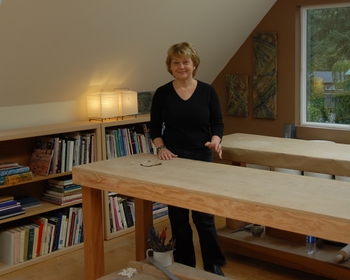
Background
Bruce and I spent hours, probably days, trying to find photographs for this website. We found cute animal photos to make a point and then couldn’t find the copyright holder. (Do we really want cute animal photos anyway?) We thought about using The New Yorker cartoons to make a point, but the copyright fees were prohibitive. (Besides The New Yorker is not exactly everyone’s cup of tea.)
Then, I had the idea to use my own artwork, which may have been a sneaky little way for me to be able to show you my work. In any event, art and artists have been a very important part of my life for the last three decades, and I am thrilled to be able to share some of that with you here. By the way, all of the photographs on this site were taken by Bruce Bugbee, a sometimes photographer.
Influences
I would like to mention three of the most important influences on my thinking about art.
Asian
The Asian aesthetic has been an important part of my life since 1976 when I went to Japan as part of an international examination team (to examine branches of multinational banks) with the Office of the Comptroller of the Currency (OCC). I was staying at the Okura Hotel in Tokyo at cherry blossom time where an ikebana master was arranging cherry blossoms for a large centerpiece arrangement in the lobby. I watched transfixed as she meditatively placed the branches into a lyrical arrangement; it was the most beautiful thing I’d ever seen. Later on that same trip, the gardens of Kyoto were the inspiration behind a lifelong love of gardens.
Vally Possony
In 1981, while I was working way too many hours with the OCC in Washington D.C., a friend nudged me to study pottery with master potter Vally Possony. Vally’s pottery style stemmed from the Japanese tradition, and she had studied with some of the great functional potters of her day. She became an aesthetic mentor and taught me much about how to live well—closer to the earth, closer to gardens, closer to beauty. If you have the time, click here to read an article I wrote about this amazing woman published in the national pottery magazine Clay Times in 1997.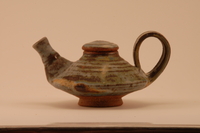
The Barnes Foundation
In 1992 and 1993 I had the privilege of studying at The Barnes Foundation in
It was the genius who amassed the collection, Dr. Alfred Barnes, and his way of looking at art and the world around him, though, that forever changed my view. For example, he talked a lot about “transferred value.” It’s a difficult concept to explain succinctly, but essentially it means that a great piece of art will remind the viewer of other values that are important. One distinct example I remember from class was a lovely little Renoir painting of a vase of flowers. But when I looked at it, it was also like looking at the sun because of the brush strokes and the “plastic” quality of the paint. As a result, the painting was about more than just a vase of flowers and was more powerful as a result.
Similarly, I think my best ceramic pieces have transferred values; for example,of a night sky, gemstones, views from under a microscope, or something dug up from antiquity.
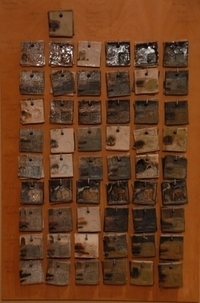
Glaze Chemistry
I began an intensive and somewhat obsessive study of glaze chemistry in 1995. I wanted to be able to combine glazes in such a way that the transferred value (as Barnes defined it) would have those qualities that I so loved. Glazing is an art unto itself, made that much more challenging when there is a requirement that the effect be repeatable. Many high-fire, reduction-based glazes are compelling but vary in result too much to be able to use them for large pieces. So, I needed to be able to create the same interesting effects again and again in an electric kiln.
This photo shows just one of 30 tile boards that I created in an attempt to understand how one chemical would affect other chemicals. I wasn’t trying to create a glaze so much as understand which chemicals created which effects.
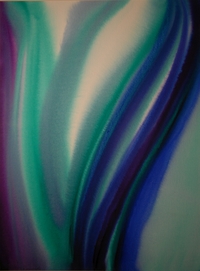
Art Shows
I had my first art show in Topanga, Califorinia, in 1990 where the local paper said “Wagner has an excellent sense of color, which she has dashed together to create fields of abstracted hues.”Here's a painting from that show. It's about 24" x 30" and watermedia (watercolor, inks, and acrylic) on paper.
My next show was at the Alex Gallery in Washington D.C. in 1993. Click here for a pdf of the brochure. Eleanor Kennelly, who writes for Art and Auction magazine, said of that show, “(Wagner) gives us images of landscape, places imagined and places remembered … Soft washes of color laced with luminescence become the shifting tones of an evening sky, a march at dawn, or a prairie … Emotion and a strong sense of mystery (on earth and beyond) pervade Wagner’s work.” That was quite a heady compliment for me.
When my father passed away in September of 2000, I wanted to do something that would honor him. He loved the North Dakota landscape, and I did a series of ceramic pieces of that landscape. Those pieces were shown at the Middle Street Gallery in Washington, Virginia. Click here for the brochure.
I have also shown my work at The Blend on Key Peninsula, WA, The Blue Peach in The Plains, Virginia, the A. L. Morency Gallery in Warrenton, Virginia, and with A Little Piece of Art, Constance Kay’s greeting cards.
Major Commissions
I was fortunate to be commissioned to build an 8-foot diameter fountain for the Lewis Ginter Botanical Garden in Richmond, Virginia. Click here for an article I wrote about this fountain for Clay Times.
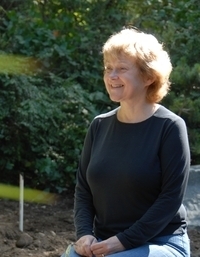
Now
About five years ago, I changed mediums and began an intensive study of textiles and related embellishments. Please see my website www.robertawagner.com which has photos and descriptions of this current work.
